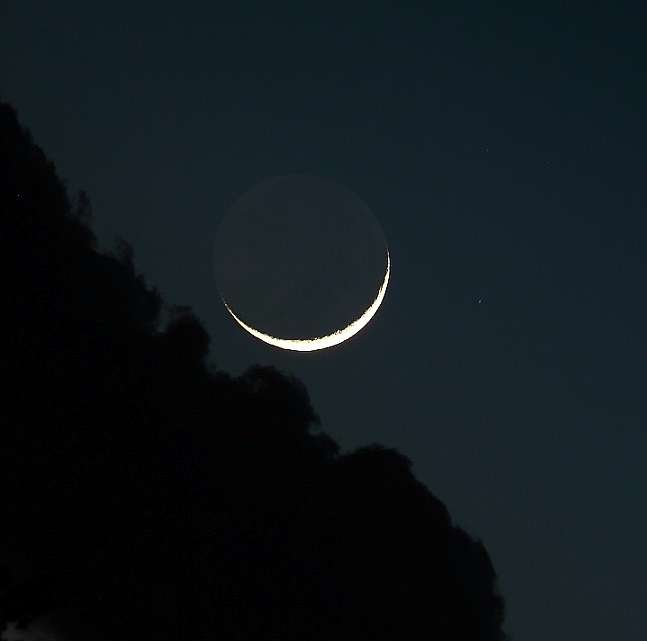by Jeff Hutton
First, did you get to see any of the Lyrid Meteors this week? As I write this, clouds are overhead but maybe it will be clear. Don’t forget to see the article from last week for meteor watching tips.
During the next week you’ll have a chance to see how the moon “grows” each evening. So, this evening, just as its getting dark, find a spot where you can go to see the sunset. I hope the clouds stay away for you! A little above the horizon and to the left (south) of where the sun went down you can see the thin crescent moon. Tonight, April 25, you will see the orange star, Aldebaran just south of the Moon. Aldebaran is the brightest star in the constellation, Taurus, the Bull, and this star represents one of his eyes. Also, you can’t miss Venus above the Moon. Look carefully at the moon. My mom used to call this a “fingernail Moon” because it looks like the thin edge of one of your
fingernails. Here’s a picture I took of the Moon in 2017 that looks like it does this Sunday.

Can you see any part of the Moon that isn’t shining so bright? If it’s very clear I bet you can! The darker part of the moon, away from the sun, is the part of the moon where it’s nighttime. But if you can see the night side of the moon it must be lit a little. It is! You’re seeing part of the Moon being lit up by sunlight that was reflected off the Earth.
TRY THIS: Find and print the Lunar Record Observing Chart, provided by our friends at the
Astronomical Society of the Pacific (ASP, www.astrosociety.org) below. Look at the upper-left box that is marked ‘Sunday’. If it’s clear Sunday evening, April 26, shade in the circle to show how the moon looks tonight. Be sure to put in the date and time, too. Don’t worry if clouds hide the moon on some evenings when you want to see the moon. Skip the days on the chart if it’s cloudy that evening. Fill in the chart for two weeks.
If we’re lucky, you’ll be able to see the moon for most of the next two weeks. In two weeks, May 7, the moon will be full. Look at your chart. Are there evenings you couldn’t see the moon and make a drawing? That’s OK, make a guess on how the moon appeared on cloudy evenings when you couldn’t see it. Use your drawings from clear evenings to estimate how the moon looked when it was cloudy.
While you’re waiting for the moon to come out look at these two pictures. I took these with my
homemade telescopes.

Why does one ‘moon’ look sharper and the other is softer?
That’s because the image on the left is the Moon and the image on the right is the planet Venus! On April 18, I used my telescope to get Venus to look as big as the Moon. From our view from Earth, Venus goes through phases just like the Moon. Venus is always covered in clouds so we never get to see its surface with telescopes. More about that later!
Think About This: Can you describe where in the sky the Moon appears when it has different
shapes?
( For instance: Is the full Moon near the sun or far away from the sun?)
Do you know the names for the different shapes of the Moon? (Hint: Look at the paragraph above.)
Let’s talk about that next week.
I hope you and your family will enjoy observing the changing shape of the moon together.
For a printable PDF click HERE.

0 Comments